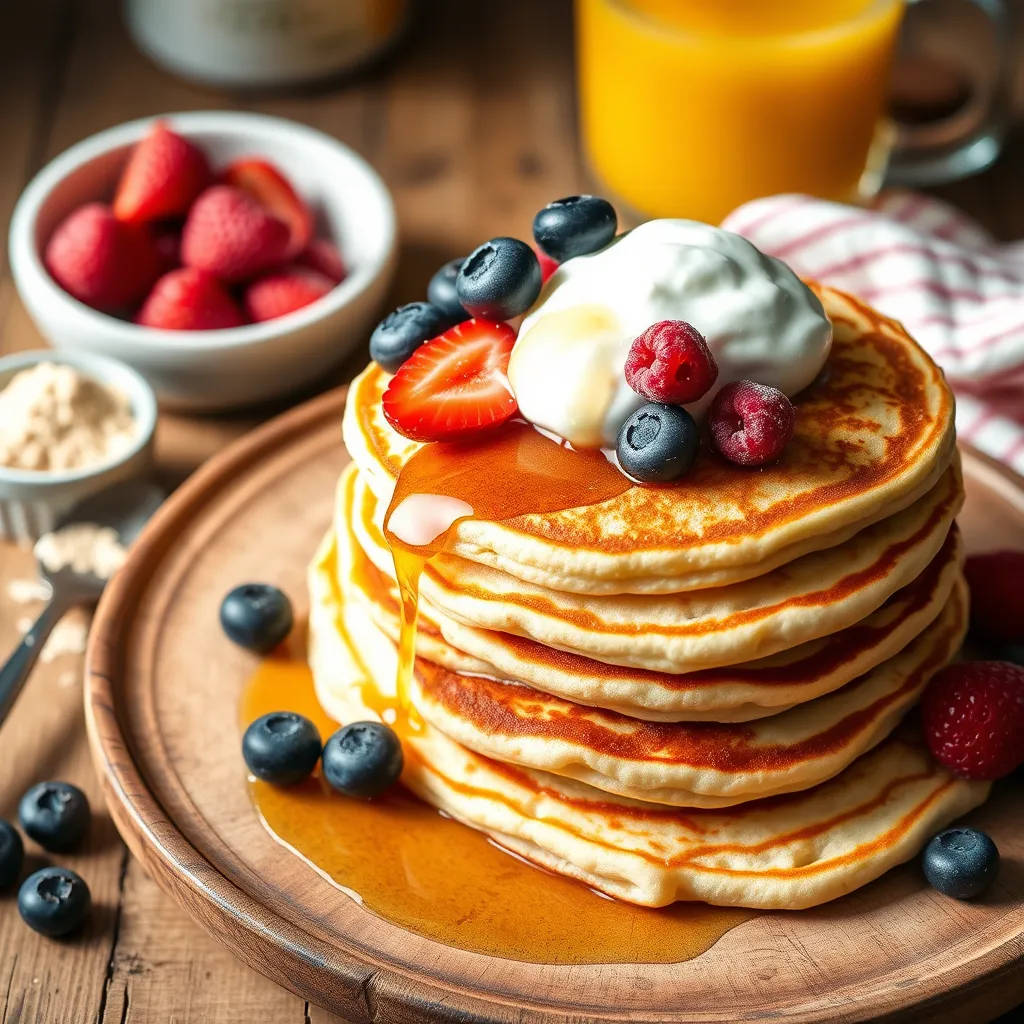Protein pancakes have become a popular breakfast option for those looking to fuel their bodies with a nutritious, filling meal. Packed with protein, fiber, and healthy fats, protein pancakes are not only a delicious way to start your day but also an excellent choice for anyone aiming to maintain or build muscle, manage their weight, or simply enjoy a healthier version of traditional pancakes. Let’s dive into everything you need to know about making the perfect protein pancakes.
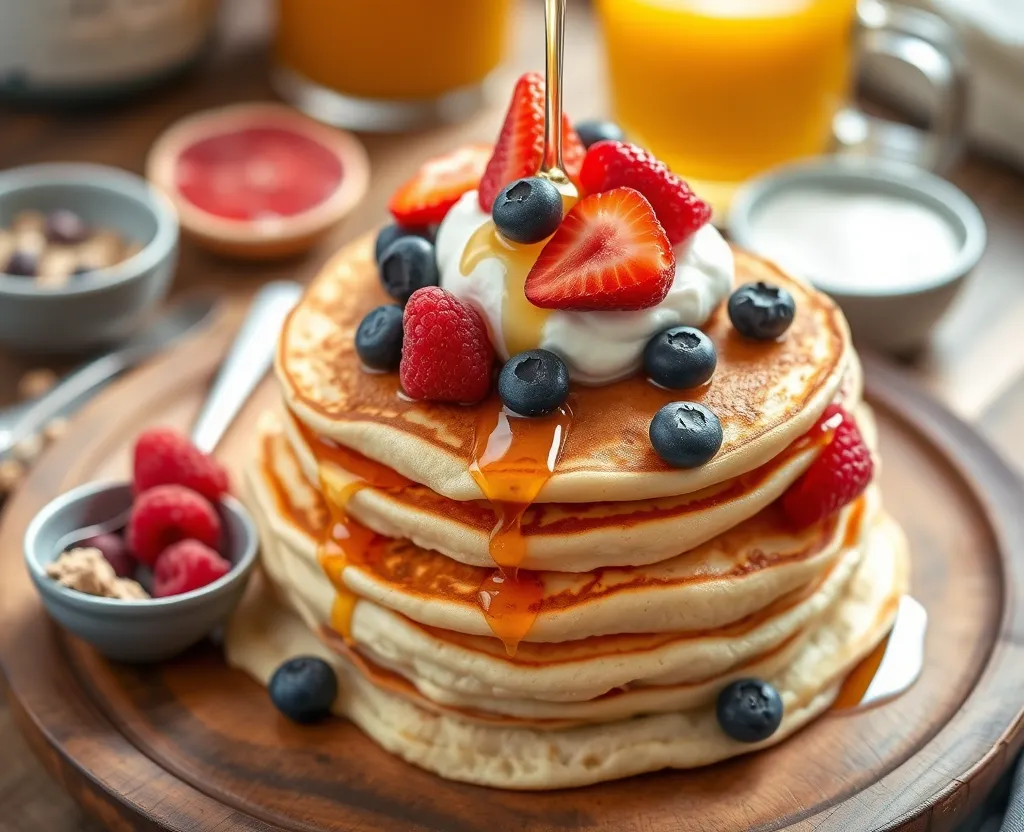
Table of Contents
Table of Contents
1. What Are Protein Pancakes?
Protein pancakes are a modified version of traditional pancakes, typically made by incorporating protein powder or other protein-rich ingredients into the batter. Unlike regular pancakes, which are primarily made from flour, eggs, and milk, protein pancakes often feature added protein from sources like whey protein, plant-based protein powders, Greek yogurt, cottage cheese, or even egg whites. This protein boost helps make the pancakes more filling and provides a nutritious way to start your day with a high-protein breakfast.
2. Why Should You Make Protein Pancakes?
Protein is an essential macronutrient that helps build and repair tissues, supports immune function, and promotes healthy skin, hair, and nails. For those who lead active lifestyles, including athletes or those who exercise regularly, protein is especially important to support muscle recovery and growth.
Protein pancakes provide several benefits:
- Increased satiety: The protein content in these pancakes can help you feel full longer, preventing mid-morning hunger.
- Supports muscle recovery: For those who work out, protein helps to repair muscles after exercise.
- Nutrient-dense breakfast: By adding ingredients like Greek yogurt, chia seeds, or oats, you can boost the nutritional profile of your pancakes with vitamins, minerals, and fiber.
- Versatility: Protein pancakes can be adapted to fit various dietary preferences, whether you prefer vegan, gluten-free, or dairy-free options.
3. Key Ingredients for Protein Pancakes
The beauty of protein pancakes lies in their flexibility. The ingredients you choose can vary depending on your dietary preferences and goals. However, there are a few key ingredients that are commonly used in making protein pancakes:
- Protein Powder: This is the main ingredient for adding protein to your pancakes. Choose your favorite type of protein powder, whether it’s whey, casein, pea protein, or hemp protein. Depending on the type of protein powder, you may need to adjust the liquid in the batter.
- Eggs or Egg Whites: Eggs provide essential proteins, fats, and nutrients. For a leaner option, you can use egg whites or a combination of whole eggs and egg whites.
- Oats or Oat Flour: Oats are a great source of complex carbohydrates and fiber. You can use whole oats or blend them into oat flour for a smooth pancake batter.
- Greek Yogurt or Cottage Cheese: These ingredients are high in protein and add a creamy texture to the pancakes. Greek yogurt can also provide probiotics, which are beneficial for gut health.
- Baking Powder: To ensure your pancakes rise and become fluffy, use baking powder.
- Sweeteners and Flavorings: You can add a natural sweetener like honey, maple syrup, or stevia to your pancakes. Flavorings like vanilla extract, cinnamon, or cocoa powder can also enhance the taste.
4. How to Make Protein Pancakes: Step-by-Step Instructions
Making protein pancakes is simple and quick. Here’s a basic recipe to get you started:
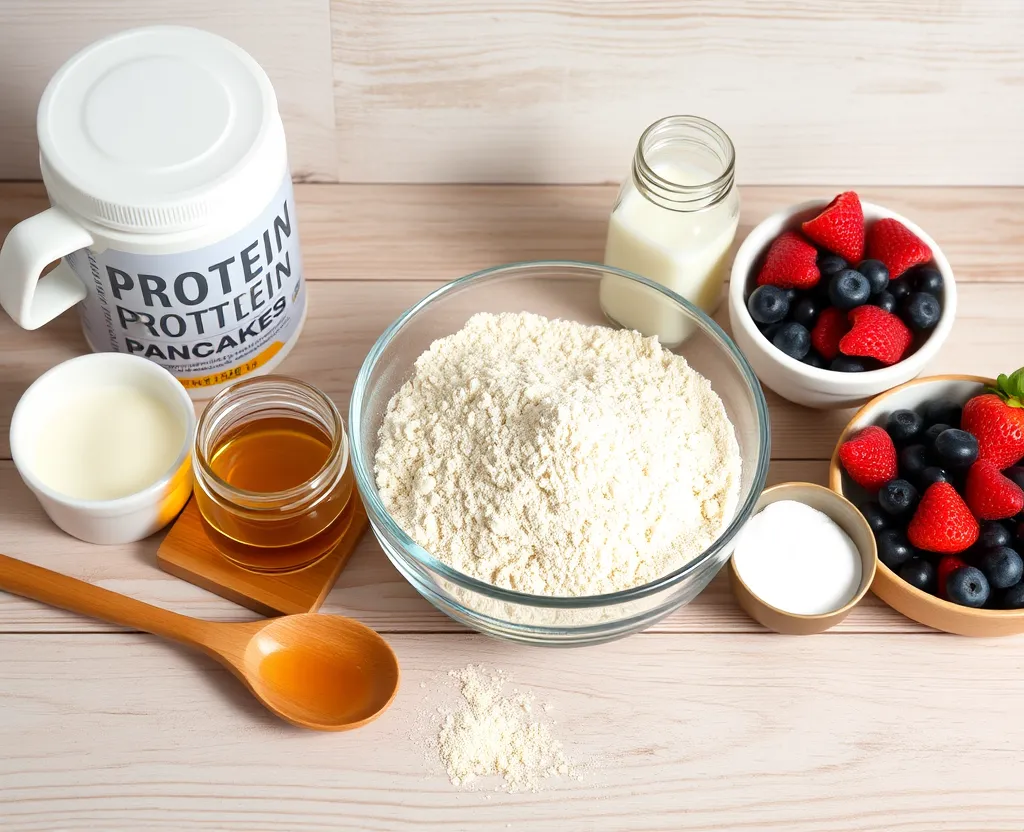
Ingredients:
- 1 scoop protein powder (vanilla or chocolate)
- 2 eggs (or 3/4 cup egg whites)
- 1/2 cup oats or oat flour
- 1/4 cup Greek yogurt or cottage cheese
- 1/2 tsp baking powder
- 1/4 cup almond milk (or any milk of choice)
- 1 tsp vanilla extract
- 1 tbsp sweetener (optional)
Instructions:
- Blend Dry Ingredients: In a mixing bowl, combine the protein powder, oats (or oat flour), and baking powder.
- Mix Wet Ingredients: In another bowl, whisk together the eggs (or egg whites), Greek yogurt, milk, vanilla extract, and sweetener (if using).
- Combine Wet and Dry Ingredients: Add the wet ingredients to the dry ingredients and mix until well combined. The batter should be thick but pourable. If it’s too thick, add more milk to reach your desired consistency.
- Cook the Pancakes: Heat a non-stick skillet over medium heat and lightly grease with oil or cooking spray. Pour 1/4 cup of the batter onto the skillet for each pancake. Cook for 2-3 minutes on each side, or until golden brown and cooked through.
- Serve and Enjoy: Top your protein pancakes with fresh fruit, a drizzle of maple syrup, or a dollop of Greek yogurt for an extra boost of protein.
5. Creative Variations of Protein Pancakes
Protein pancakes are highly customizable. Here are a few ideas for flavor variations:
- Chocolate Peanut Butter Protein Pancakes: Add a spoonful of peanut butter to your batter and top with cocoa powder or chocolate chips for a rich, indulgent flavor.
- Berry Protein Pancakes: Fold fresh berries like blueberries, strawberries, or raspberries into the batter for a fruity twist.
- Banana Protein Pancakes: Add mashed banana to the batter for natural sweetness and extra potassium.
- Cinnamon Roll Protein Pancakes: Add cinnamon, vanilla extract, and a swirl of honey or maple syrup to create a cinnamon roll-inspired flavor.
6. Nutritional Benefits of Protein Pancakes
Protein pancakes are not only a delicious breakfast option but also a nutritious one. Here’s a quick breakdown of the benefits:
- High in Protein: One serving of protein pancakes can provide around 20-30 grams of protein, depending on the ingredients used. This makes them an excellent choice for muscle recovery or those who want to increase their protein intake.
- Balanced Macronutrients: With a good balance of protein, carbs, and healthy fats, protein pancakes are great for fueling your body throughout the morning.
- Low in Sugar: By using whole food ingredients and minimal sweeteners, protein pancakes can be a low-sugar option compared to traditional pancakes, which are often loaded with syrup and refined sugars.
7. Conclusion
Protein pancakes are an excellent way to upgrade your breakfast routine. By swapping out traditional pancake ingredients for protein-packed alternatives, you can create a filling and nutritious meal that supports your health and fitness goals. Whether you’re looking to build muscle, curb your appetite, or just enjoy a healthier pancake, protein pancakes offer a great solution. With endless flavor variations and the ability to customize based on your dietary preferences, protein pancakes are a breakfast choice that everyone can enjoy.
Health Benefits of Protein Pancakes
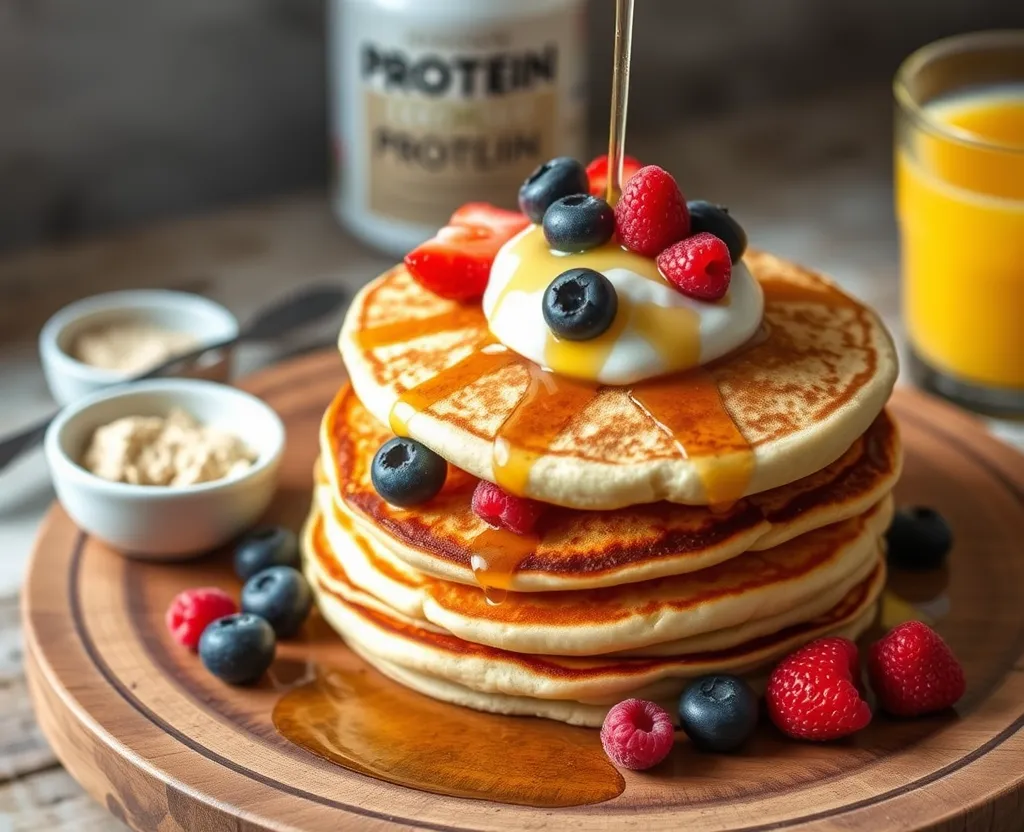
Protein pancakes offer a delicious and nutritious way to boost your protein intake while enjoying a satisfying meal. Whether you’re an athlete, fitness enthusiast, or simply looking for a healthy breakfast, protein pancakes can provide a range of health benefits. Let’s explore how these pancakes can support your health goals.
1. Muscle Building and Repair
One of the primary benefits of protein is its role in muscle building and repair. Protein is a crucial macronutrient needed for the growth and recovery of muscle tissue. If you’re engaging in physical activity, particularly strength training or resistance exercises, your body requires additional protein to repair muscle fibers that are broken down during workouts. Protein pancakes, made with high-quality protein powders, provide a convenient and tasty way to increase protein intake, helping to enhance muscle growth, recovery, and performance.
2. Improving Satiety and Appetite Control
Protein is known for its satiating effects, meaning it helps you feel full longer. This is particularly beneficial for people trying to manage their weight or reduce calorie intake. Protein takes longer to digest than carbohydrates, leading to prolonged feelings of fullness and helping to curb unnecessary snacking throughout the day. By incorporating protein pancakes into your diet, you can start your day with a meal that provides lasting satisfaction, reducing the likelihood of overeating or reaching for unhealthy snacks later.
3. Stabilizing Blood Sugar Levels
Protein pancakes can also contribute to stabilizing blood sugar levels. When consumed with a source of fiber, such as whole grains or fruit, protein pancakes provide a balanced meal that slows the absorption of sugars into the bloodstream. This prevents the blood sugar spikes and crashes that can occur after eating high-carb, low-protein meals. Stabilizing blood sugar is especially important for people with diabetes or those looking to maintain energy levels throughout the day.
4. Supporting Weight Loss and Maintenance
For those looking to lose weight or maintain a healthy weight, protein is essential. It helps increase the thermic effect of food (TEF), which is the energy required to digest, absorb, and metabolize food. The higher your TEF, the more calories your body burns during digestion. Additionally, a high-protein diet can help reduce fat storage by improving metabolic function and regulating hormones related to hunger. Protein pancakes, when incorporated into a balanced diet, can be an effective tool in weight management.
5. Supporting Immune Function
Protein plays a vital role in supporting the immune system. Antibodies, which are proteins in the body, help fight off infections and protect against pathogens. Adequate protein intake is essential for maintaining immune function, especially during times of illness or high physical stress. By including protein-rich pancakes in your diet, you can support your immune system and overall health.
6. Promoting Healthy Skin, Hair, and Nails
Another important benefit of protein is its role in maintaining healthy skin, hair, and nails. Collagen, a type of protein, is essential for skin elasticity and the growth of hair and nails. Consuming adequate amounts of protein helps promote the production of collagen, keeping your skin firm, youthful, and smooth. For healthy hair and nails, protein provides the building blocks necessary for growth and strength. Protein pancakes, which provide a rich source of protein, can therefore contribute to your beauty and skin-care goals.
7. Better Overall Health
In addition to the specific benefits mentioned above, protein supports a wide array of functions in the body. It helps regulate hormones, enzymes, and neurotransmitters, supporting everything from metabolism to mood. Protein is also essential for maintaining bone health, as it supports the structure of bones and helps with calcium absorption. By including protein pancakes in your diet, you can give your body the nutrients it needs to function optimally.
Best Protein Powders for Protein Pancakes
When it comes to making protein pancakes, the choice of protein powder can greatly influence the texture, taste, and nutritional value of the final product. Different types of protein powders offer unique benefits, and selecting the right one depends on your dietary preferences, health goals, and taste preferences. Here, we’ll explore some of the best protein powders for making protein pancakes: whey protein, casein protein, pea protein, and brown rice protein. We’ll discuss how each protein powder differs in terms of health benefits, digestion, and its impact on the texture and flavor of your pancakes.
1. Whey Protein
Whey protein is one of the most popular and commonly used protein powders, especially for those looking to build muscle or recover after workouts. It is derived from milk and contains all nine essential amino acids, making it a complete protein.
Health Benefits:
- Muscle building and recovery: Whey protein is known for its fast digestion and absorption, making it ideal for post-workout recovery. It quickly replenishes amino acids that support muscle repair and growth.
- Immune support: Whey protein also contains immunoglobulins, which support the immune system.
- Rich in BCAAs (Branched-Chain Amino Acids): BCAAs, especially leucine, help in muscle synthesis and may reduce muscle soreness.
Digestion:
Whey protein is digested and absorbed quickly by the body, which can help with immediate muscle recovery, but it may not be suitable for people with lactose intolerance or milk allergies due to the lactose content in whey.
Texture and Flavor:
Whey protein creates a light and fluffy texture in pancakes. It has a mild flavor, so it blends well with other ingredients without overpowering the taste. However, some people may find the flavor too “milky” or sweet, especially if the whey is flavored.
2. Casein Protein
Casein protein is another milk-derived protein but has a slower digestion rate compared to whey. It forms a gel-like consistency in the stomach, allowing for a gradual release of amino acids over several hours.
Health Benefits:
- Slow release of protein: Because casein digests slowly, it provides a prolonged source of amino acids, which can be beneficial for muscle repair and recovery over a longer period. It’s ideal for taking before bedtime to provide sustained muscle-building support overnight.
- Improved satiety: Due to its slow digestion, casein protein helps you feel fuller longer, which can aid in weight management and prevent overeating.
Digestion:
Although casein protein is slower to digest, it may be a better option for those who prefer a steady release of protein, especially overnight. Like whey protein, casein can cause digestive discomfort in individuals with lactose intolerance.
Texture and Flavor:
Casein creates a denser, creamier texture in pancakes compared to whey. This can lead to a thicker, more substantial pancake that holds up well. Casein’s flavor is subtle and not as sweet as whey, but it can lend a slightly richer texture to the batter.
3. Pea Protein
Pea protein is a plant-based protein powder derived from yellow split peas. It’s a popular choice for vegetarians, vegans, and those looking for non-dairy, hypoallergenic options.
Health Benefits:
- Rich in iron: Pea protein is an excellent source of iron, which is especially beneficial for vegetarians or vegans who may be at risk of iron deficiency.
- Heart health: Pea protein has been shown to support cardiovascular health by lowering blood pressure and cholesterol levels.
- Allergen-friendly: Unlike whey or casein, pea protein is free from dairy, gluten, and soy, making it suitable for people with allergies or sensitivities.
Digestion:
Pea protein is highly digestible and does not cause the bloating or gas that some other plant-based proteins do. It is easy on the stomach and provides steady energy throughout the day.
Texture and Flavor:
Pea protein has a slightly earthy flavor, which can be more noticeable in baked goods like pancakes. To balance out the flavor, you can add natural sweeteners or vanilla extract. In terms of texture, pea protein creates a somewhat grainy, denser pancake compared to whey or casein, though it still provides a satisfying bite.
4. Brown Rice Protein
Brown rice protein is another plant-based option derived from whole brown rice. It’s often combined with other plant proteins to form a complete protein, as rice protein is lower in certain essential amino acids.
Health Benefits:
- Easily digestible: Brown rice protein is hypoallergenic and free from dairy, soy, and gluten, making it an excellent option for people with sensitivities.
- Rich in antioxidants: Brown rice protein contains antioxidants that help reduce oxidative stress and inflammation in the body.
- Muscle support: While not as high in certain essential amino acids as other protein sources, brown rice protein still provides a decent amount of muscle-building benefits when consumed regularly.
Digestion:
Brown rice protein is highly digestible and gentle on the stomach. It’s often favored by individuals with sensitivities to dairy or soy, as it does not cause bloating or discomfort.
Texture and Flavor:
Brown rice protein has a mild, slightly nutty flavor. In pancakes, it can contribute to a somewhat crumbly texture compared to whey or casein. However, its neutral flavor pairs well with a variety of pancake toppings like fruit, nut butter, or syrup.
Different Types of Flour and Flour Substitutes for Protein Pancakes
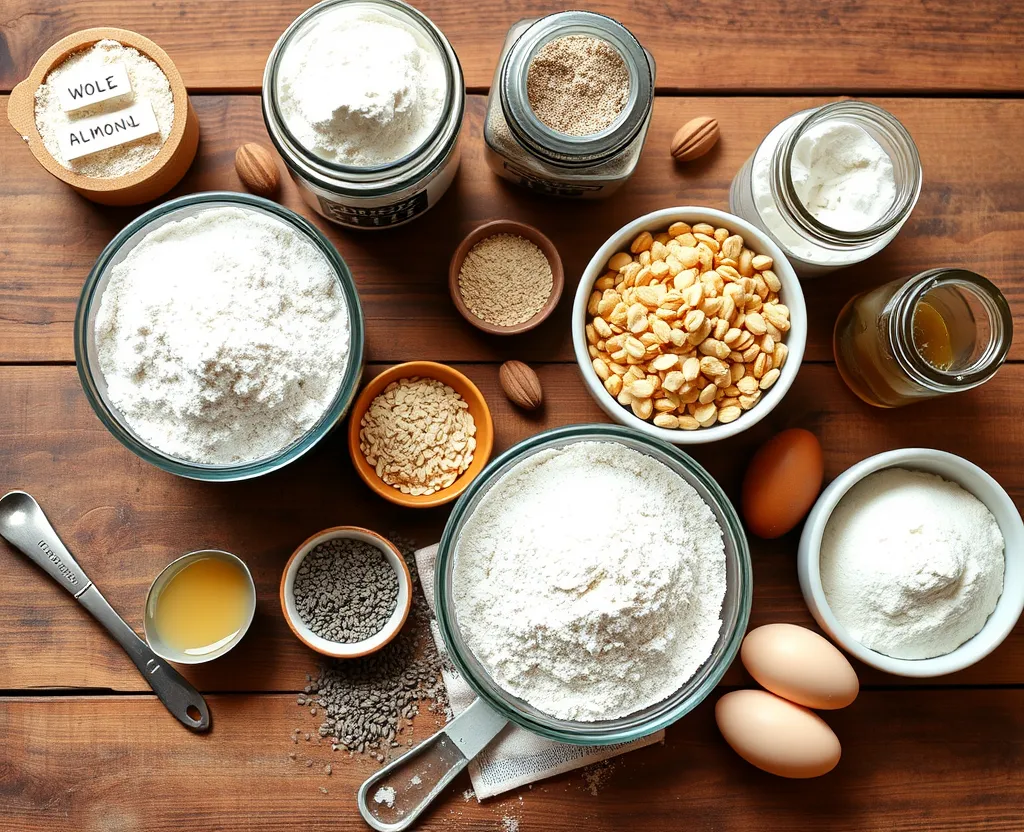
The flour you choose for making protein pancakes plays a significant role in the texture, taste, and nutritional content of the final dish. While traditional flour is commonly used in pancake recipes, there are various alternatives that cater to different dietary needs, such as gluten-free options, low-carb flours, and higher-protein varieties. Let’s explore some of the most popular flours and flour substitutes for making protein pancakes, and how they affect the texture and flavor of your pancakes.
1. Oat Flour
Oat flour is made by grinding whole oats into a fine powder. It’s a popular choice for pancakes because it provides a mild, slightly sweet flavor and a soft, tender texture.
Health Benefits:
- High in fiber: Oat flour is rich in soluble fiber, which helps to regulate digestion and keep you feeling full longer.
- Gluten-free: Oat flour is naturally gluten-free, making it an excellent option for those following a gluten-free diet. However, it’s important to ensure that the oats are certified gluten-free, as cross-contamination with wheat can occur during processing.
- Supports heart health: The beta-glucan fiber found in oats has been shown to help reduce cholesterol levels and support cardiovascular health.
Texture and Flavor:
Oat flour provides a soft, fluffy texture to pancakes and a naturally sweet flavor. When used in combination with protein powder, oat flour helps balance the richness of the protein, giving the pancakes a hearty, satisfying bite without being too dense or dry.
Best Use:
Oat flour works well in a variety of pancake recipes, particularly when combined with whey or pea protein powder. It’s ideal for people looking for a more wholesome, fiber-packed alternative to traditional flour.
2. Almond Flour
Almond flour is made from finely ground almonds and is a popular choice in low-carb, keto, and gluten-free diets. It has a rich, nutty flavor and is higher in healthy fats than traditional flour.
Health Benefits:
- High in protein and healthy fats: Almond flour is a great source of plant-based protein and heart-healthy fats, both of which can contribute to improved muscle maintenance and better overall health.
- Low in carbs: Almond flour is naturally low in carbohydrates, making it an excellent choice for those on a low-carb or keto diet.
- Rich in vitamins and minerals: Almond flour provides a good amount of vitamin E, magnesium, and other essential nutrients.
Texture and Flavor:
Almond flour creates a denser, more moist pancake due to the fat content in almonds. The nutty flavor can enhance the overall taste of your protein pancakes, giving them a rich, satisfying flavor that pairs well with berries, honey, or almond butter.
Best Use:
Almond flour is perfect for those following a low-carb or keto lifestyle. It can be used on its own or in combination with other gluten-free flours like oat flour or coconut flour for added texture.
3. Coconut Flour
Coconut flour is a highly absorbent flour made from dried coconut meat. It’s a great option for those following gluten-free, paleo, or low-carb diets and adds a subtle coconut flavor to pancakes.
Health Benefits:
- High in fiber: Coconut flour is extremely high in fiber, which aids digestion and supports long-lasting feelings of fullness.
- Gluten-free and grain-free: Like almond flour, coconut flour is naturally gluten-free and grain-free, making it an excellent alternative for those avoiding gluten or grains.
- Rich in healthy fats: Coconut flour contains medium-chain triglycerides (MCTs), a type of fat that’s known for supporting weight loss and boosting energy levels.
Texture and Flavor:
Coconut flour is very absorbent, so it typically requires more liquid than other flours when used in pancake recipes. The texture of pancakes made with coconut flour tends to be a little more dense and slightly crumbly. The flavor is subtly coconutty, which can add an exotic touch to your pancakes.
Best Use:
Coconut flour works best when paired with a liquid-rich batter, like a mix of eggs and milk, to help maintain moisture. It’s a great choice for adding extra fiber and flavor to protein pancakes, especially when combined with vanilla protein powder for a more tropical taste.
4. Chickpea Flour
Chickpea flour, or besan, is made from ground chickpeas and is a great gluten-free flour option. It’s rich in protein and fiber, making it a popular choice for higher-protein pancake recipes.
Health Benefits:
- High in plant-based protein: Chickpea flour is a great source of protein, which makes it ideal for enhancing the protein content of your pancakes.
- Rich in fiber: Chickpea flour is also high in fiber, which supports digestion and helps maintain healthy blood sugar levels.
- Packed with nutrients: It provides important vitamins and minerals such as iron, magnesium, and folate, making it a nutrient-dense flour choice.
Texture and Flavor:
Chickpea flour has a slightly nutty flavor and a denser, firmer texture compared to other flours. It’s best when used in combination with other flours to lighten the texture of the pancakes.
Best Use:
Chickpea flour is a great option for people who want to add extra protein to their pancakes. It can be used on its own or combined with almond flour or oat flour for a balanced, gluten-free pancake recipe.
5. Gluten-Free All-Purpose Flour
If you’re looking for a more traditional flour option without the gluten, gluten-free all-purpose flour is a great choice. It’s often made from a blend of rice flour, potato starch, and tapioca flour and is designed to mimic the texture and function of wheat flour.
Health Benefits:
- Versatile: Gluten-free all-purpose flour can be used as a direct substitute for wheat flour in most pancake recipes, which makes it a great option for people with gluten sensitivities or celiac disease.
- Nutrient-dense options available: Some gluten-free flour blends are fortified with additional nutrients, such as fiber, iron, and B vitamins, to help make up for the lack of nutrients typically found in wheat-based products.
Texture and Flavor:
Gluten-free all-purpose flour has a neutral flavor and a similar texture to regular flour. It can produce pancakes that are light and fluffy, making it an excellent choice for those who miss traditional pancakes but need to avoid gluten.
Best Use:
Gluten-free all-purpose flour is ideal for anyone with gluten sensitivities. It can be used as a one-to-one replacement for wheat flour in most pancake recipes, and it pairs well with various protein powders, such as whey or pea protein.
4. The Role of Healthy Fats in Protein Pancakes
When preparing protein pancakes, healthy fats are not only an essential part of the recipe for enhancing flavor and texture, but they also provide numerous health benefits that help balance the overall nutritional profile of the dish. Healthy fats help create a satiating meal that keeps you full for longer and are key in supporting various bodily functions.
Why Healthy Fats Matter
- Improved Flavor and Texture: Healthy fats, such as coconut oil, avocado oil, and nut butters, contribute to the rich, moist texture of protein pancakes. They make the pancakes tender and golden brown when cooked. Healthy fats also help create a more satisfying mouthfeel, adding to the overall experience of eating your pancakes.
- Vitamin Absorption: Certain vitamins, especially fat-soluble vitamins like A, D, E, and K, are better absorbed by the body when consumed with healthy fats. Incorporating healthy fats into your pancakes can aid in the absorption of these important nutrients, especially if you’re using ingredients like spinach, kale, or other nutrient-dense toppings.
- Balanced Macronutrient Profile: While protein is key to muscle building and satiety, healthy fats play a crucial role in maintaining a balanced macronutrient profile. Including healthy fats ensures that your protein pancakes are not only filling but also provide a source of long-lasting energy, preventing blood sugar spikes and crashes.
Best Sources of Healthy Fats for Protein Pancakes
- Coconut Oil:
Coconut oil is a popular choice for cooking protein pancakes due to its ability to withstand high heat without losing its nutritional properties. It adds a subtle coconut flavor and provides a healthy dose of medium-chain triglycerides (MCTs), which are quickly converted into energy by the body. - Avocado Oil:
Avocado oil is another excellent fat source that is rich in monounsaturated fats, which are known for their heart-healthy benefits. It also has a neutral flavor, making it a versatile option for protein pancake recipes. - Nut Butters:
Nut butters such as almond butter, peanut butter, or cashew butter are great for adding healthy fats, flavor, and a creamy texture to your protein pancakes. They are also packed with additional protein and fiber, which makes them a perfect complement to the protein powder in your pancake batter. - Flaxseeds and Chia Seeds:
Both flaxseeds and chia seeds are excellent sources of omega-3 fatty acids, which are essential for brain health and reducing inflammation in the body. Adding a tablespoon of either of these seeds to your protein pancake batter provides an extra boost of healthy fats and fiber.
5. Tips for Choosing the Best Ingredients for Protein Pancakes
The key to making delicious and nutritious protein pancakes lies in the quality of ingredients you use. By selecting the best possible ingredients, you can ensure that your pancakes are not only tasty but also packed with nutrients to fuel your day. Here are some essential tips for choosing the right ingredients for your protein pancakes.
1. Selecting High-Quality Protein Powder
Protein powder is the main source of protein in protein pancakes, so it’s important to choose one that is high-quality and suits your dietary preferences.
- Whey Protein: If you don’t have any dietary restrictions, whey protein is an excellent choice. It is a complete protein, meaning it contains all nine essential amino acids, and is quickly absorbed by the body. Choose a whey protein isolate for a lower sugar and carb content.
- Plant-Based Protein: For those who are lactose intolerant or following a vegan diet, plant-based proteins such as pea protein, brown rice protein, or hemp protein are great options. They are typically lower in fat but still provide a solid amount of protein.
- Casein Protein: For a slower-digesting option, casein protein is a great choice. It digests more slowly than whey, providing a longer-lasting source of protein, which is particularly useful for keeping you full throughout the morning.
2. Choosing the Right Milk (Dairy or Dairy-Free)
The type of milk you choose for your protein pancakes will not only affect the texture but also the overall flavor of the pancakes.
- Dairy Milk: If you’re not following a dairy-free diet, regular cow’s milk is a great option for protein pancakes. It adds creaminess and helps in achieving a smoother batter. Choose whole milk for a richer texture or low-fat milk for a lighter option.
- Almond Milk: A popular dairy-free alternative, almond milk is a great choice for those avoiding animal products. It has a subtle nutty flavor and is typically lower in calories than cow’s milk. Look for unsweetened varieties to keep the sugar content low.
- Oat Milk: Oat milk is another excellent dairy-free option with a slightly sweet flavor and creamy texture. It adds richness to protein pancakes and works well with a variety of flavors.
3. Natural Sweeteners
Sweeteners can enhance the flavor of your protein pancakes without the added sugar. Here are some options to consider:
- Stevia: A natural, calorie-free sweetener, stevia can be used to sweeten your pancakes without the added calories. It’s much sweeter than sugar, so use it sparingly.
- Honey or Maple Syrup: If you prefer a more traditional option, honey or pure maple syrup can add natural sweetness and complement the flavor of the pancakes. Both options also provide small amounts of vitamins and minerals.
- Monk Fruit Sweetener: Another natural, zero-calorie option, monk fruit sweetener provides a sweet taste without affecting blood sugar levels. It’s a good choice for people who are watching their carbohydrate intake.
4. Enhancing the Creaminess with Greek Yogurt or Cottage Cheese
For an extra creamy texture without adding unnecessary sugar, Greek yogurt or cottage cheese can be used in your protein pancake batter. Both ingredients are high in protein and add moisture to the pancakes, helping them stay tender and fluffy.
- Greek Yogurt: Packed with probiotics and protein, Greek yogurt is a great addition to pancake batter. It makes the pancakes soft and fluffy while adding a slight tang to the flavor.
- Cottage Cheese: If you enjoy a thicker texture, cottage cheese can also be blended into the pancake batter. It adds a rich, creamy consistency and is also an excellent source of protein.
5. Add-ins for Extra Flavor and Texture
To make your protein pancakes more exciting, consider adding a variety of mix-ins like chocolate chips, berries, nuts, or seeds. These ingredients provide extra texture, flavor, and nutrients to your pancakes.
By carefully selecting high-quality ingredients, you can create protein pancakes that not only taste amazing but also meet your nutritional needs. Whether you prefer a plant-based protein powder, a dairy-free milk alternative, or natural sweeteners, these choices will help elevate the flavor, texture, and overall health benefits of your pancakes.

